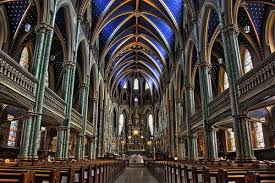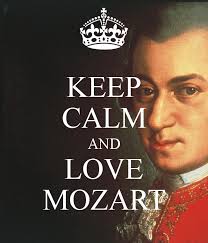 Dostoyevsky wrote, through the voice of Prince Myskin in his novel, The Idiot, that ‘beauty would save the world’.
Dostoyevsky wrote, through the voice of Prince Myskin in his novel, The Idiot, that ‘beauty would save the world’.
I have often wondered about that quotation, and whether it be true. A month or so ago, our Schola choir traveled to a parish 2 hours from where I live, to sing Schubert’s Mass in E flat minor, at an old rite ceremony, in honour of the parish’s 75th anniversary. A glorious occasion, with music to suit, but the crowd was thin on the ground.
Then again, the parish may have thinned out ever since they rebuilt the new church after a fire in 1959. The old church, from photographs and paintings I saw, was gloriously beautiful, a small replica of Saint Anne de Beaupre in Quebec.
The new structure? A vast A-frame, built to look like a tee-pee, with a huge back window with a design that appeared like nothing else but splattered paint, reminiscent of a Jackson Pollock ‘painting’. There was little statuary in the vast, cavernous nave, just one of Our Lady placed there high in the sanctuary by the new parish priest (to replace a rather hideous previous version).
Beauty and ugliness in the same space. But what we find in most spaces, liturgical or otherwise, is just plain ugliness, or at least mediocrity. We have become used to such, wallowing in what is objectively not beautiful, and this ugliness has become connatural to us, part of the very fibre of our being. This, as I will explain, makes us inured, quite literally anaesthetic, to beauty.
Beauty has three basic criteria, which Saint Thomas describes briefly in his description of God in the Summa Contra Gentiles (his ‘other’ Summa besides the Summa Theologica). They are integrity, proportion and clarity.
Integrity: Is everything necessary for the thing to be what it is, present? Is it missing a nose, eyes? Are things chipped off, or paint peeling?
Proportion: Presuming all is present, are all the parts or elements duly proportioned? Is one part too dominant or large, and another too small?
Clarity: Does the thing signify what it truly is? Or does it try to play false, or is it in a strange environment and out of place? A car that looks ‘beautiful’ on a freeway may not look so good in a swimming pool. And an attractive woman does not appear so attractive in army gear, or in manly attire.
 These are more or less objective criteria for beauty, which we can measure and judge. We know a ‘beautiful’ person when we see one, and the same goes for houses and landscapes, art and literature. Who does not recognize a Mozart piano sonata as beautiful, as perfectly proportionate, integral and clear? One sees a hint of such an appreciation of beauty in the following exchange in the 1984 film Amadeus, between Mozart and the Emperor Joseph II, after Mozart plays one of his new pieces for him:
These are more or less objective criteria for beauty, which we can measure and judge. We know a ‘beautiful’ person when we see one, and the same goes for houses and landscapes, art and literature. Who does not recognize a Mozart piano sonata as beautiful, as perfectly proportionate, integral and clear? One sees a hint of such an appreciation of beauty in the following exchange in the 1984 film Amadeus, between Mozart and the Emperor Joseph II, after Mozart plays one of his new pieces for him:
MOZART: So then you like it? You really like it, Your Majesty?
EMPEROR: Of course I do. It’s very good. Of course now and then – just now and then – it gets a touch elaborate.
MOZART: What do you mean, Sire?
EMPEROR: Well, I mean occasionally it seems to have, how shall one say? [he stops in difficulty; turning to Orsini-Rosenberg] How shall one say, Director?
ORSINI-ROSENBERG: Too many notes, Your Majesty?
EMPEROR: Exactly. Very well put. Too many notes.
MOZART: I don’t understand. There are just as many notes, Majesty, as are required. Neither more nor less.
Just so.
Yet, and yet, why do so many people like the Emperor not appreciate beauty? Why are orchestras and choirs, art centres and museums, struggling even to survive? Why does ugliness in art and music flourish?
The answer may lie in two other related principles from the thought of Saint Thomas: that beauty is also what he describes as id quod visum placet, that which pleases upon being seen. Following upon this, we tend to love those things that are connatural to us, those things that are like us, that correspond to our nature.
These two principles imply that there is also a strong subjective dimension to beauty. It is not just about things being in due proportion, whole and fitting to their nature. Rather, beauty is also to some degree in the eye of the beholder.
This is why some love Bach, other Mozart, still others Debussy, and why some are drawn in visual art to the realists, the impressionists, Rembrandt or Caravaggio. Some things accord more (or less) with who we are, our own histories, our memories, our likes and dislikes, our loves and our own passions. Most are drawn to physical material beauty. Few can see the moral and spiritual beauty beneath an unpleasing facade.
Even further: Besides the ‘good’ side of various kinds of beauty, we may consider, as has happened especially in our age, that many are drawn to what is in fact downright ‘ugly’. They find such things ‘beautiful’ because their own nature has become deformed, and thus is connatural to such discord. What is objectively unpleasing they find subjectively pleasing. One need not stray far in one’s imagination to consider examples: Misogynistic rap music, sappy modern church music, discordant symphonies, much of modern abstract art, all the way to pornography and the gratuitous uber-violence of modern video gaming.
Such as these find true beauty repulsive, for it is, to them, contrary to their (deformed) nature. We may have heard the reports of corner stores playing Mozart over their speakers to keep loitering teenagers away. They hear beauty, they run. Play rap or Eminem, they congregate.
How I wish I could hear more classical music in repair shops, department stores and elevators, but, sappy is what sappy sells. Comfort music for comfortable shoppers.
So what to do? Separate into two camps, the appreciators of true beauty on one side, and the modern philistines and morlocks who disdain such art? That is effectively what has happened, but it should not be so. The objective nature of beauty takes precedence, for it does indeed accord with and even elevate man’s nature, as made in the image of God, who is the ‘most beautiful’ , the cause and exemplar of all beauty. As the Book of Wisdom declares,
For from the greatness and beauty of created things comes a corresponding perception of their Creator
Thus, we should not despair, for even those most distant from true beauty are always somewhat drawn to it. We need only witness the popularity of stories, movies, novels that signify such beauty, whether on the moral, visual or other aesthetic levels. For all true beauty is but a window into God Himself.
I just watched the recent Cindarella film, a sumptuous tale filled with resplendent beauty, not just physical, but, more to the point, moral. There is no real ‘religion’ in the movie, but we do see the triumph of good over evil, humility over pride, generosity over selfishness, and the rewards of a life well-lived.
We all know this deep down, which is why rebellion against true beauty always ends ultimately in failure. Likely one of the many causes of the downfall of Communism was the sheer ugliness of its architecture and art. We may soon see the same occur for Islam, which, in its ‘orthodox’ interpretation, disdains, even revolts against, any art or music, since, ironically, they claim it derogates from the pure worship of God. Witness ISIS and its destruction of ancient monuments in Syria and Iraq.
Au contraire. Beautiful art and music lead us to God, and one of the primary attractions of the Catholic Church, and the Christian civilization which she inspired, is the beauty of her music, liturgy and architecture (sadly, now in danger of being lost in our own iconoclastic era in love with mediocrity). As the Constitution on the Sacred Liturgy, Sacrosanctum Concilium, put it
Very rightly the fine arts are considered to rank among the noblest activities of man’s genius, and this applies especially to religious art and to its highest achievement, which is sacred art. These arts, by their very nature, are oriented toward the infinite beauty of God which they attempt in some way to portray by the work of human hands; they achieve their purpose of redounding to God’s praise and glory in proportion as they are directed the more exclusively to the single aim of turning men’s minds devoutly toward God.
Amongst all the artistic treasures of the Church, the greatest of them all is her musical heritage, in her chant, polyphony and untold beautiful melodies and harmonies:
The musical tradition of the universal Church is a treasure of inestimable value (pretii inaestimabilis), greater even than that of any other art.
We will have much more to write on art and music in these pages, but, for now, we return to our Schola choir, and the small but worthy efforts to present and keep this treasure alive and well, even in, or perhaps especially in, a not-so-beautiful church. Eventually, such beauty may pierce even the most hardened souls, and will certainly elevate those souls already close to God.
For to appreciate, and especially to create, true beauty requires some level of education, discipline and patience, a mind and soul that are refined and educated, instead of wallowing in its passions, always eager for the next quick fix of emotional adrenaline. For aesthetic ugliness is easy. It is beauty that requires work.
But we need such true beauty more than ever in our chaotic world filled with so many ugly images, so that we see beyond such distortions, and be led one step closer to God and His infinite beauty. I can end this reflection with no more fitting words that those from the great Saint John Paul II in his 1999 Letter to Artists:
…my hope for all of you who are artists is that you will have an especially intense experience of creative inspiration. May the beauty which you pass on to generations still to come be such that it will stir them to wonder! Faced with the sacredness of life and of the human person, and before the marvels of the universe, wonder is the only appropriate attitude.
From this wonder there can come that enthusiasm of which Norwid spoke in the poem to which I referred earlier. People of today and tomorrow need this enthusiasm if they are to meet and master the crucial challenges which stand before us. Thanks to this enthusiasm, humanity, every time it loses its way, will be able to lift itself up and set out again on the right path. In this sense it has been said with profound insight that “beauty will save the world”.(25)
Beauty is a key to the mystery and a call to transcendence. It is an invitation to savour life and to dream of the future. That is why the beauty of created things can never fully satisfy. It stirs that hidden nostalgia for God which a lover of beauty like Saint Augustine could express in incomparable terms: “Late have I loved you, beauty so old and so new: late have I loved you!”
 Today is the feast of Saint Andrew, Apostle, brother of Saint Peter, patron of Scotland, Russia, Ukraine and Greece, for what reason are somewhat historically obscure. Here is the Wikipedia take on the matter, whether accurate or not, it fits:
Today is the feast of Saint Andrew, Apostle, brother of Saint Peter, patron of Scotland, Russia, Ukraine and Greece, for what reason are somewhat historically obscure. Here is the Wikipedia take on the matter, whether accurate or not, it fits: Officer James Furcillo, yes, the man who shot Sammy Yatim eight times, five while he was lying prostrate mortally wounded on the ground, now admits that his primary motivation was to ‘get home safe and sound to his family’, and that police officers are ‘not paid to get stabbed or shot’.
Officer James Furcillo, yes, the man who shot Sammy Yatim eight times, five while he was lying prostrate mortally wounded on the ground, now admits that his primary motivation was to ‘get home safe and sound to his family’, and that police officers are ‘not paid to get stabbed or shot’. The U.N. Climate Summit has now begun, with our Prime Minister declaring in his role as anti-global-warming-(or-is-that-climate-change?) warrior that ‘Canada is back’. Back from what, one may ask? From the chilly days of Conservative and eco-foe Stephen Harper? I will post an article soon on so-called climate science, and how unscientific it has become. For starters, carbon dioxide is not a pollutant, and is in fact the ‘air’ of plants, which are necessary for life, as well as the normal exhalation of humans. A perfect balance, one would think. There is little evidence that it actually produces global warming, which has sort of stopped over the past generation (hence, the unfalsifiable and hence pseudoscientific thesis of ‘climate change’). But then Trudeau would not permit his mind to dwell upon that ‘inconvenient truth’, for, as a man of slogans, his intellectual grasp of reality seems, well, slim. Pray for the attendees, and for the truth of what they are trying to do to sink in.
The U.N. Climate Summit has now begun, with our Prime Minister declaring in his role as anti-global-warming-(or-is-that-climate-change?) warrior that ‘Canada is back’. Back from what, one may ask? From the chilly days of Conservative and eco-foe Stephen Harper? I will post an article soon on so-called climate science, and how unscientific it has become. For starters, carbon dioxide is not a pollutant, and is in fact the ‘air’ of plants, which are necessary for life, as well as the normal exhalation of humans. A perfect balance, one would think. There is little evidence that it actually produces global warming, which has sort of stopped over the past generation (hence, the unfalsifiable and hence pseudoscientific thesis of ‘climate change’). But then Trudeau would not permit his mind to dwell upon that ‘inconvenient truth’, for, as a man of slogans, his intellectual grasp of reality seems, well, slim. Pray for the attendees, and for the truth of what they are trying to do to sink in.







